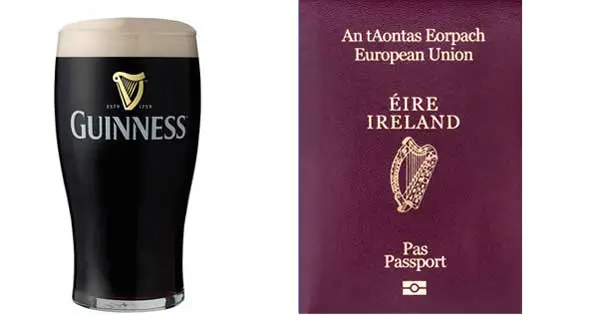With the harp being such a hardworking emblem for Ireland, you might think the powers that be could at least agree on which way round it should appear.
Sadly, it’s not that simple.
If you pause for a second in between sips of your pint of Guinness, you’ll see that the harp on the glass has the straight edge on your left and the curved edge on your right. The strings slope upwards from left to right as you look at it.
However, if you then look at your Irish passport, or any official Irish government document, you’ll find the straight edge is on the right and with curved edge on the left. The strings slope slightly from right to left.
It didn’t happen by chance. It dates back to the 19th century when Guinness decided to start using the harp as an emblem on its iconic drink. It was a predictable choice. The harp had long been a symbol of Ireland due to the popularity of the instrument in the hands of the numerous Irish harpists who were famed for their skills throughout Europe.
Henry the VIII liked the instrument so much he made it the official emblem of Ireland and had it stamped on Irish coins when he declared himself the country’s new king in 1541.
However, 60 years later his daughter Elizabeth I came to see harpists and harps as symbols of Irish rebellion and ordered their destruction as way of wiping out Irish identity. She ordered her officials “to hang the harpers wherever found and destroy their instruments”.
This certainly had the effect of making the harpists lie low, but it didn’t kill the spirit of the Irish as Elizabeth hoped. Instead, it made the harp even more a symbol of Irishness and Irish resistance. It often featured as a symbol of Irish independence in the various rebellions against British rule.
In the 1860s, Guinness adopted the O’Neill harp, sometimes referred to as the Brian Boru harp, as the emblem on its Guinness glasses. It proved popular so the company registered it as a trademark in 1862.
This created a problem with the government of the new Irish Free State when it wanted to use the harp as the official symbol of Ireland in 1922. Guinness put business before patriotism and wouldn’t yield on its trademark, so the government decided to simply show the harp the other way round, and that’s how it remains to this day.
In the meantime, the harp has been used more and more as symbol of Ireland, although companies must get permission from the government to use it.
Many travellers across the world will have seen the harp figure on the tailfin of Ryanair planes. The Ryanair version features a female figure flying, a nod to Ériu, a goddess of Ireland.
If you prefer to go on holiday aboard a plane using that other great symbol of Ireland, the shamrock, you’ll need to fly Aer Lingus.
One final word on Guinness, it deepened its relationship with the harp by using it as the name of its new lager launched back in 1960 with the slogan: Harp…stays sharp to the bottom of the glass.
The harp – national emblem of Ireland
King Henry, Queen Elizabeth and how the harp became the emblem of Ireland
How Ireland protects its harp and shamrock emblems
